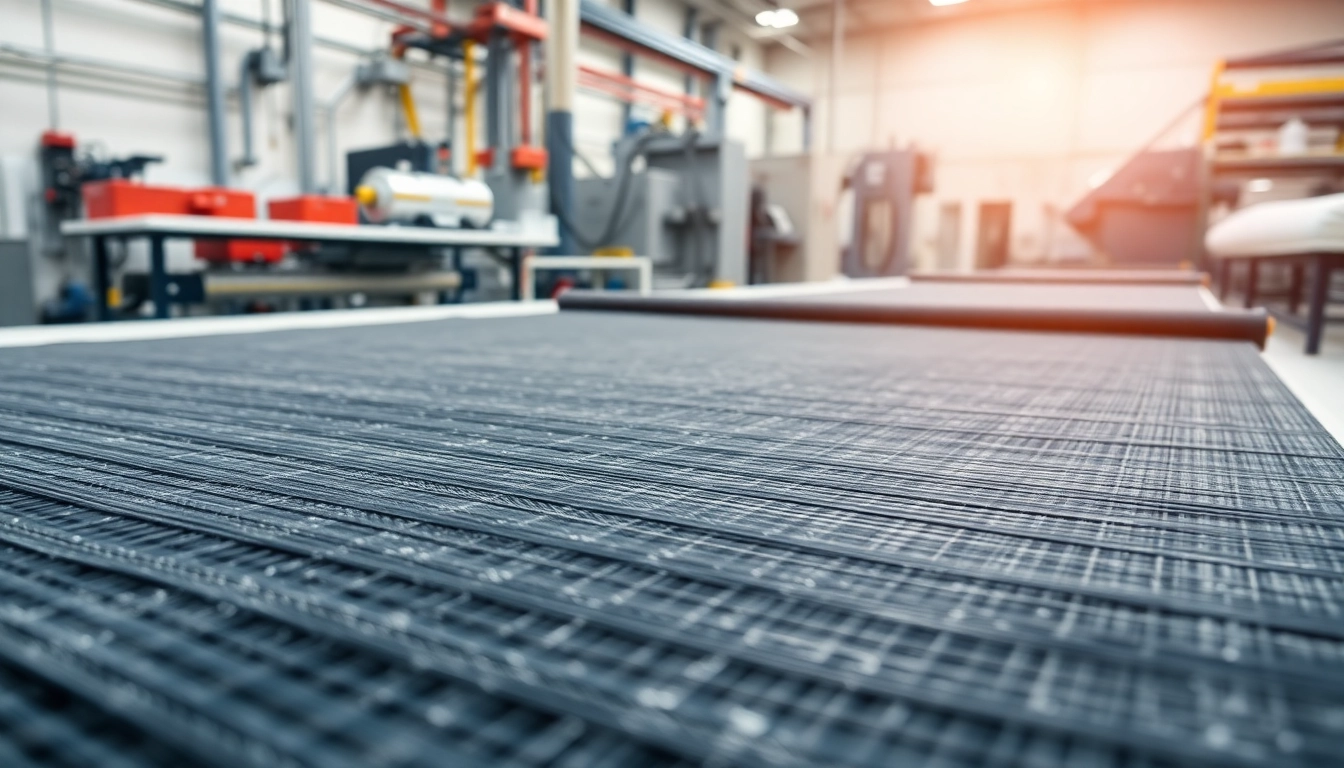What Are Epoxy Prepregs?
Definition and Composition
Epoxy prepregs are composite materials consisting of reinforcing fibers pre-impregnated with a thermoset epoxy resin. This advanced material combines the structural integrity of the fibers with the bonding capabilities of epoxy, resulting in a versatile product often used in demanding applications. The prepreg process involves saturating the reinforcing fibers, typically carbon, glass, or aramid, with a liquid epoxy resin system that is partially cured, which ensures that the fibers are uniformly coated.
This pre-impregnation allows for better control over the resin content and distribution, leading to superior mechanical properties in the final product. Manufacturing processes generally aim to optimize these characteristics, resulting in epoxy prepregs that deliver enhanced performance attributes such as reduced weight, improved fatigue resistance, and excellent environmental durability. For more insights into these materials, consider exploring epoxy prepregs.
Manufacturing Process
The fabrication of epoxy prepregs involves several critical steps. Initially, the reinforcing fibers are prepared, often through weaving or layering techniques based on the desired mechanical properties and application requirements. The next step is to coat these fibers with the epoxy resin, which is done in controlled environments to prevent premature curing. This process can vary between manufacturers but typically employs techniques such as:
- Wet Lay-Up: In this method, epoxy resin is applied to the fibers manually, allowing for high customization.
- Film Infusion: This process involves the application of a film layer of resin onto the fibers before curing, aiding in optimal resin distribution.
- Hot Melt Film Adhesives: Prepregs can also utilize heat-reactive adhesives that bond the resin to the fibers effectively during curing.
Once the fibers are impregnated with resin, they are partially cured to a “B-stage” to stabilize the resin and prevent it from flowing before final processing. This state allows for easier handling and shaping in various applications. Finally, the prepreg rolls or sheets are packaged and stored under specific conditions to maintain their functionality until ready for use.
Types of Epoxy Prepregs
Epoxy prepregs are categorized based on several criteria, including fiber type, resin chemistry, and curing temperature. Key types include:
- Carbon Fiber Prepregs: Known for their superior tensile strength and stiffness, these prepregs are predominantly used in aerospace and automotive applications.
- Glass Fiber Prepregs: Offering good strength at reduced cost, these are popular in construction and industrial applications.
- Aramid Fiber Prepregs: Renowned for their impact resistance and toughness, these are often used in protective applications.
- High-Performance Epoxy Prepregs: Specifically formulated for extreme conditions and environments, suitable for military and space applications.
These various types illustrate the versatility of epoxy prepregs and highlight the tailored solutions offered based on specific industry demands.
Applications of Epoxy Prepregs
Aerospace Industry
The aerospace sector benefits significantly from epoxy prepregs due to their high strength-to-weight ratio and excellent fatigue resistance. These materials are employed in structural components, such as wings and fuselage frames, where performance and safety are paramount. For instance, the use of epoxies enables the construction of lightweight yet durable components, ultimately contributing to fuel efficiency and overall aircraft performance.
Furthermore, their resistance to harsh environmental conditions, including extreme temperatures and moisture, makes them ideal for aerospace applications. Recent innovations involve integrating smart materials into epoxy prepregs that can monitor structural integrity and provide real-time data, enhancing operational safety.
Automotive Innovations
In the automotive industry, epoxy prepregs are increasingly utilized for manufacturing lightweight yet robust components. The drive toward lighter vehicles for improved fuel efficiency has led automakers to adopt composite materials extensively. Epoxy prepregs are often used in body panels, chassis components, and structural reinforcements, providing significant weight savings without compromising safety and performance.
Additionally, advancements in curing processes allow manufacturers to produce components with complex geometries and optimal surface finishes, appealing to modern manufacturing needs. The adaptability of epoxy prepregs to various shapes not only reduces production costs but also enhances design possibilities.
Sports Equipment and Outdoor Gear
The sports and outdoor equipment industry has also embraced epoxy prepregs for their impressive performance characteristics. High-performance bicycles, helmets, and sporting goods utilize these composites to achieve lightweight designs that do not sacrifice safety or durability. In products such as racing bicycles, epoxy prepregs allow for the production of frames that are not only strong but also capable of absorbing shocks and vibrations, improving the overall riding experience.
Moreover, their resistance to environmental stressors makes epoxy prepregs suitable for outdoor gear, ensuring longevity and reliability under various conditions.
Advantages of Using Epoxy Prepregs
Consistent Quality and Performance
One of the standout advantages of epoxy prepregs is the consistency they offer in quality and performance. Since the resin is pre-impregnated into the fibers, users can expect uniform resin distribution, leading to consistent mechanical properties across batches. This predictability is crucial in industries where performance and reliability are non-negotiable, such as aerospace and automotive.
Additionally, the pre-impregnation process allows manufacturers to exploit advanced techniques in automation and handling, ensuring that the final products maintain a high-performance standard consistently.
Weight Reduction and Strength
Epoxy prepregs contribute significantly to weight reduction in various applications. Given their high strength-to-weight ratio, engineers can design components that are lighter without compromising structural integrity. This attribute is especially advantageous in industries like aerospace and automotive, where reducing weight translates directly into better fuel efficiency and performance.
The use of epoxy prepregs allows for more innovative designs that sometimes incorporate hollow sections, reducing material usage while enhancing performance metrics.
Handling and Processing Benefits
Handling epoxy prepregs is less complicated compared to conventional resin systems, as they are easier to work with due to their stable state before final curing. This stability leads to fewer mistakes during the application process, resulting in reduced waste and increased efficiency. Furthermore, the processing time can be optimized since the prepregs can be stored and staged for assembly without the risk of premature curing.
Additionally, the ability to produce complex geometries with precision is a notable processing advantage, leading to better fitting components and less need for post-processing.
Challenges in Working with Epoxy Prepregs
Temperature Sensitivity and Storage Requirements
Despite their advantages, working with epoxy prepregs involves certain challenges, particularly concerning temperature sensitivity. They require strict storage conditions, typically at low temperatures, to prolong shelf life and ensure performance upon curing. If not maintained correctly, the resin may begin to cure prematurely, leading to unusable materials and increased production costs.
Adopting temperature-controlled storage solutions and stringent inventory management practices can help mitigate these issues.
Cost Considerations
Another challenge is the cost associated with epoxy prepregs. Although their performance benefits often justify the initial investment, the high cost of raw materials and manufacturing processes can be prohibitive, especially for smaller companies or projects with limited budgets. Convincing stakeholders of the long-term benefits requires a thorough cost-benefit analysis, demonstrating not only performance improvements but also potential operational savings.
Technical Skills for Application
Effective application of epoxy prepregs necessitates skilled personnel due to their specific processing requirements. Workers must be trained in handling, laying up, and curing these materials to harness their full potential. Organizations may need to invest in training programs or collaborate with experts to ensure that their workforce is equipped with the necessary skills to work with these advanced materials.
As industry standards evolve, ongoing education will play a critical role in maximizing the benefits and applications of epoxy prepregs.
Future Trends in Epoxy Prepreg Technology
Innovations in Resin Formulation
The future of epoxy prepregs looks promising with ongoing innovations in resin formulation. Researchers are exploring new resin chemistries aimed at improving properties like toughness, thermal stability, and curing speeds. Customized formulations that can cater to specific application requirements are likely to emerge, enhancing the adaptability of prepregs across various sectors.
Additionally, modifications that allow for ambient or lower-temperature curing will expand their usability and processing flexibility, making them more accessible for diverse manufacturing needs.
Environmental Sustainability Initiatives
With increased awareness of environmental impacts, there is a growing emphasis on sustainability in the composites industry. Efforts are being made to develop bio-based epoxy prepregs that utilize renewable resources and offer a reduced carbon footprint. Potential initiatives may include the recycling of prepreg materials and reengineering processes to minimize waste, contributing positively to environmental sustainability.
Market Projections and Opportunities
Market projections for epoxy prepregs indicate robust growth, driven by advancements in technology and increasing adoption across various sectors, including automotive, aerospace, and renewable energy. As industries continue to seek lightweight and high-performance materials, epoxy prepregs are poised to capture a significant share of the advanced composites market.
As research progresses and new applications arise, opportunities for innovation and product development will likely expand, further solidifying the role of epoxy prepregs in future manufacturing processes.








